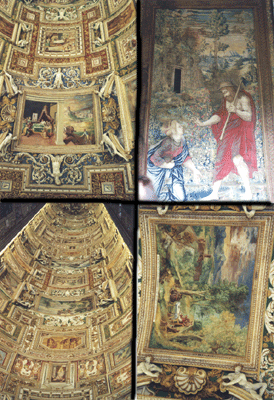
Monday, July 24, 2000 Day 9
We were up early and out by 7:00 a.m. to get to the Vatican Museum and Sistine Chapel. This link to the Vatican museum is the only one I could find that actually shows the paintings, tapestries, etc. Here are some pictures Maureen had taken of the Vatican Museum:

We were the second group in line before the many groups of people go in. We had a showing of the museum and Sistine Chapel like President Clinton would have had. We were not standing neck and neck with people. That is what it would have been like had we gone later. After a certain time, when they are opened to the general public, you are no longer allowed to speak so the guide would not have been able to explain what we were seeing. This is another aspect which is nice about Central Holidays. They really aim to please. Here are some pictures from the Sistine Chapel.

The State of Vatican City would hold but 400 homes in a typical suburban home complex. Just 3,000 work in these 108 acres, and only 400 call it home. Despite this insignificant physical presence, it's one of the most important states on the globe. Important for its influence on other countries and Roman Catholics around the world. Important because of its history.
Important, certainly, to visitors to Rome for its collection of art and architecture, both in the Museums and throughout the property ... which includes, of course, St. Peter's Basilica, Basilica San Pietro. This is the largest church in the Christian world. "Upon this rock I shall build my church". The Basilica of St. Peter, in which the most important ceremonies of the Catholic Church are celebrated, stands on the site of a much smaller basilica erected in the years 324 - 349 by will of the Roman emperor Constantine to honor the tomb of the first Pope, the apostle Peter. The first stone of the new church was laid on April 18, 1506 by Pope Julius II at the base of the column of Veronica. The four colossal columns and the connecting arches on which the dome rests, aligned with the saint's tomb, was the work of Donato Bramante, the inspiration behind the initial project of the "new St. Peter's".
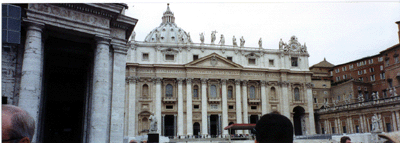
Once you enter St. Peter's Square or the Museums you've left Italy. The museums and church fill a large portion of the city state, but much is quite private. Some of the private portions including the 'Scavi' (Necropolis ... City of the Dead) and Gardens may be visited by tourists with reservations.
Well the Vatican Museum was quite astonishing as was the Sistine Chapel. The Vatican museums are immense, with four and one half miles of corridors. The ramp up which you walk from the lower entrance is a double helix. (There are two ramps nestled inside one another. If you leave the museum the same way you'll actually walk down a different pathway.)
The Sistine Chapel is the piece de resistance.
When looking at all these beautiful paintings, I felt such a feeling of astonishment and awe.
Michelangelo first gained fame as a sculptor and always considered himself such. The Pieta, David, Moses and others are unsurpassed. It was Pope Julius II who, literally, forced Michelangelo to paint the ceiling. Michelangelo did not want to since he knew nothing of painting.
Julius, in the end, was clearly correct in his assessment of the artist's skills, as nothing has come close to matching the Sistine Chapel frescoes. And despite being probably the most artful sculptor the world has seen, Michelangelo's Sistine works clearly classifies him as en even better painter.
Here are some pictures form the Vatican:
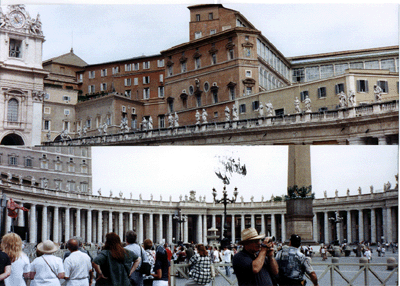
These are the Papal Doors (your visa into heaven). I guess I am all set:

This is the only finished Pieta Michelangelo signed. It is behind glass because some years back someone tried to damage it but they restored it and you would never know anything happened to it.

This picture below shows the comparison of Jason's hand with the angel's hand. It shows how large the church is because this church is the largest in the Christian world. Everything was done to scale.
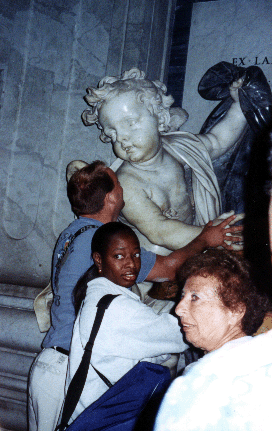
After the tour, we shopped at the Vatican store, and then we got a bite to eat. We then boarded the bus for a tour of Ancient Rome. We stopped at the Colosseum. The Colosseum is an elliptical building made to hold 50,000 spectators for sporting and theatrical events. It is four stories high with rings of arcades on the first three levels. The arches have attached three-quarter columns, Doric on the first level, Ionic on the second, and Corinthian on the third. The top story has Corinthian pilasters. From here a large awning, the vlarium, could be stretched across the entire amphitheater. The Coliseum was constructed under three Flavian em perors, Vespasian, Titus, and Dominitan. More than any other single building, its construction details, engineering, and sense of power and authority speak to the Roman culture. It took 8 years to build and rises to 165 feet. In one of the pictures you can see the outside structure of the Colosseum, in another the stairs we climbed, and in the others, the inside of the Colosseum. There are different ways of spelling Colosseum. I do not know which one is the correct way so I included both spellings.


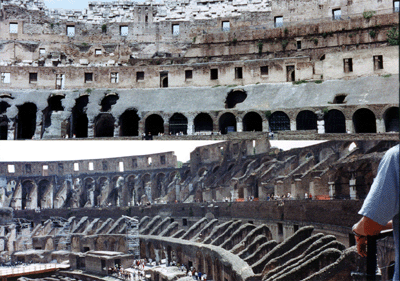

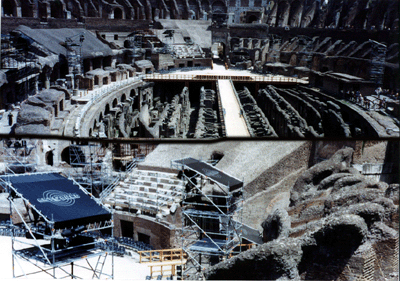
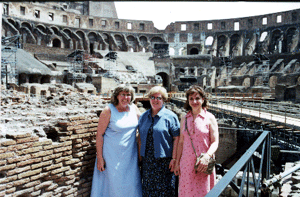
Tonight, we dined at a local restaurant. We had three pastas, and a choice of veal or lamb for dinner. I think the name of the restaurant was the Ristorante Ambasciolo d' Alzuzzo. We had eggplant, recotta, bruschetta, and Ravioli with spinach and cheese. After supper, we took a tour of Rome at night. We stopped at the Trevi Fountain and threw in our three coins.
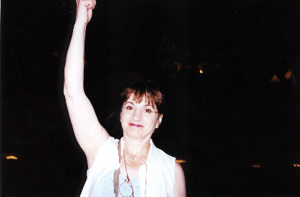
One wish is for you, another for someone you love and the third one is so that you will return to Rome. The Trevi fountain was built by the architect Salvi in 1735 and decorated by several artists of Bernini's school. It is the front of a large palace decorated with statues and bas-reliefs on heaps of rocks. The fountain is not only celebrated for its excellent water but for the legend that whoever throws a coin in the fountain, will return to Rome.
| Day 1 | Day 2 | Day 3 |
| Day 4 | Day 5 | Day 6 |
| Day 7 | Day 8 | Day 9 |
| Day 10 | Day 11 | Day 12 |
| Day 13 | Day 14 | Day 15 |